What do B2B Customer Journeys Look Like in 2024?
We walk through how B2B businesses should approach constructing the ideal customer journey in 2024.
We walk through how B2B businesses should approach constructing the ideal customer journey in 2024.
A B2B customer journey refers to all the interactions that take place between a business and a customer as the latter moves through the funnel. But in a B2B context, the customer in question is usually acting on behalf of their organization (e.g., a team of stakeholders looking to bring in a new email automation tool into their MarTech stack).
As a result, B2B customer journeys are usually much longer than business-to-customer (B2C) interactions – sometimes culminating in months-long exchanges that require input from multiple decision-makers.
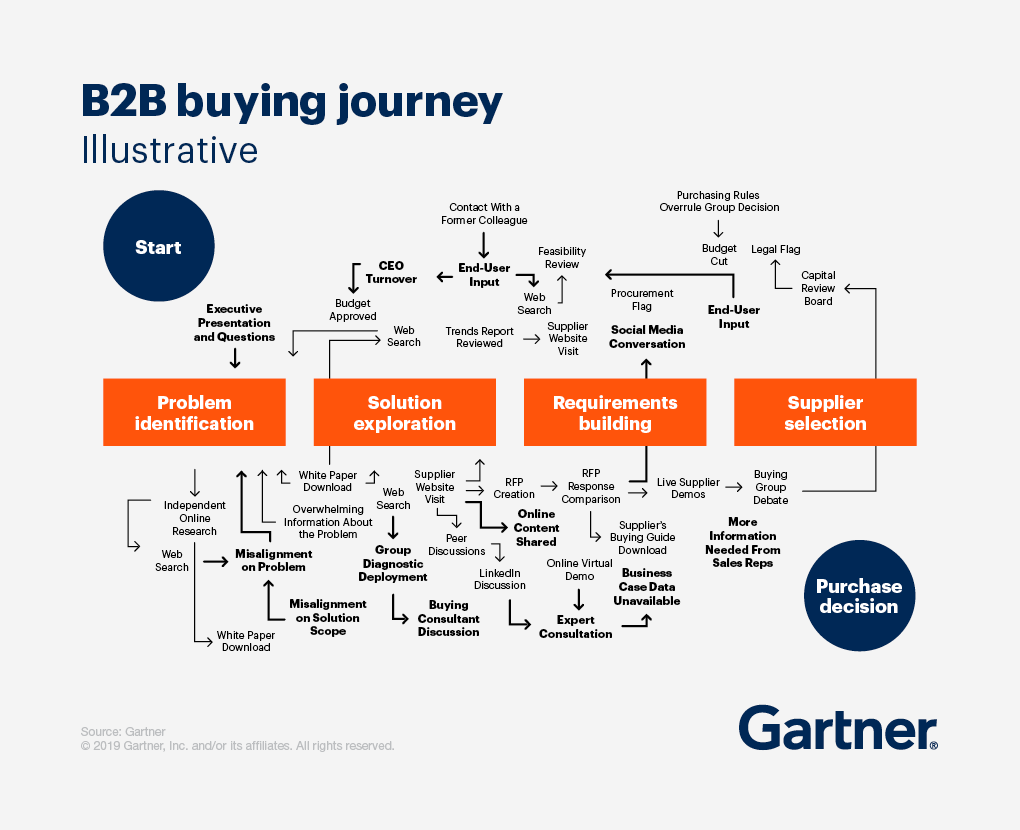
The customer journey describes all the interactions that take place between a customer and a business. It starts before a customer discovers your product and continues beyond the point of sale.
While they’re are key distinctions, both (B2B) and (B2C) customer journeys share the same five basic stages:
This is when a customer becomes aware of a specific pain point or need they have, and starts searching for a solution. From a business perspective, this is where having a sharp understanding of your audience and target personas comes into play. When driving brand awareness, you’ll often cater your messaging to speak to each individual and relevant persona. For instance, if you’re marketing a live chat tool, when advertising to a potential end user you’d likely showcase specific features and its ease of use. But when promoting it to someone in upper management, you may focus on the ROI their business stands to gain.
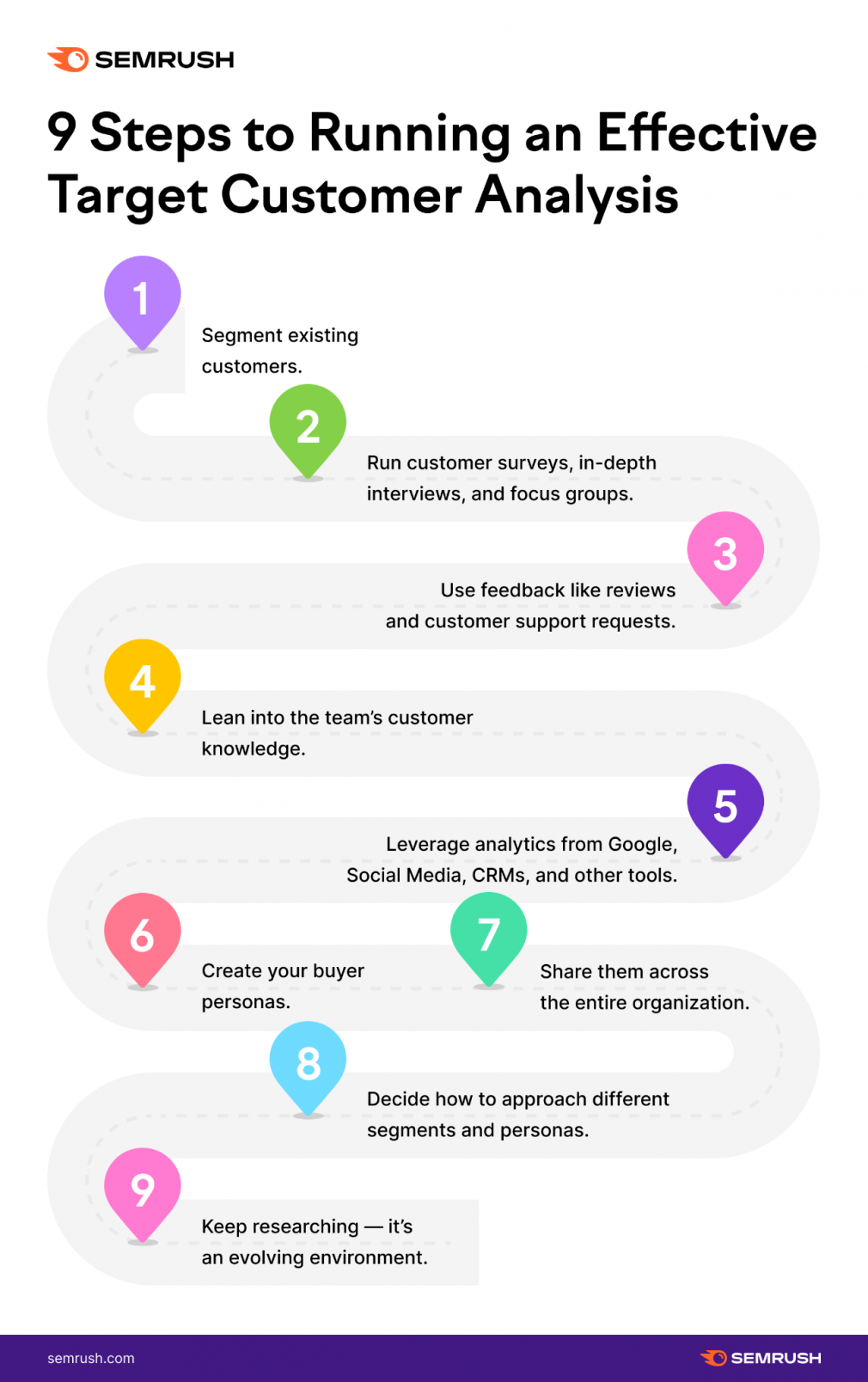
The consideration stage is when a prospect discovers your product or service as a potential solution to their problem. This can look like: browsing relevant product pages on your site, requesting a demo, speaking with live chat bot – a sort of fact-finding mission to understand how your product stacks up to their expectations (and why it’s better than your competitors). As we said earlier, in a B2B setting this process can take a long time due to the multiple stakeholders involved in making a decision.
The conversion is the point when the customer makes a decision to commit to your brand, perhaps by signing up for an account or committing to a premium subscription (whatever your ultimate conversion goal happens to be).
Conversion is not the end of the road, though. Once a customer starts using your product or service, a new facet of the customer journey begins: one that’s concerned with helping them reach time-to-value as quickly as possible and preventing churn. This is where personalized onboarding flows can come into play, and when onboarding journey maps can be especially useful to have a solid idea of what milestones your customers should be hitting and when.
This step-by-step guide describes how to implement 5 user onboarding campaigns to drive long-term loyalty.
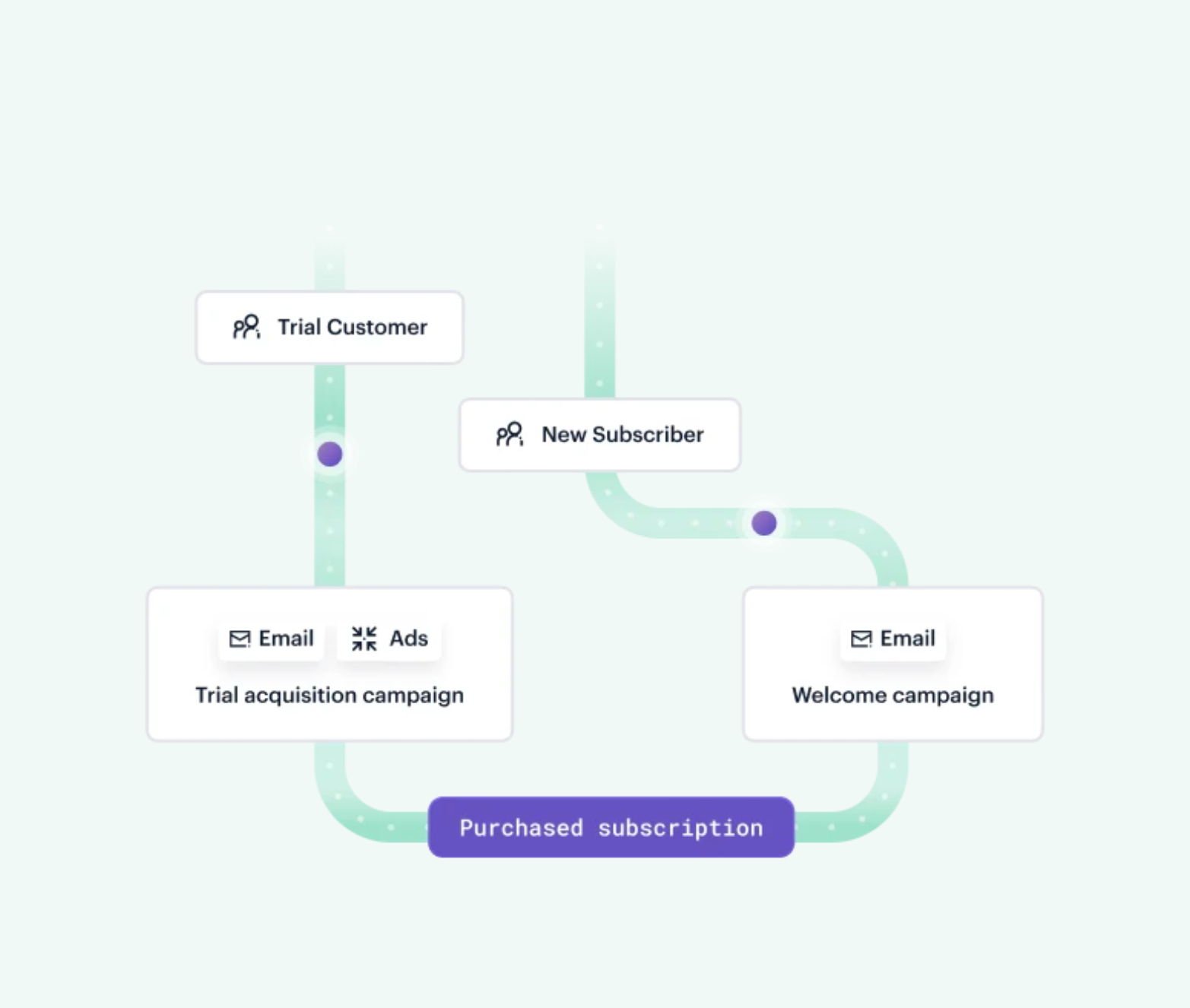
Thank you for downloading this content. We've also sent a copy to your inbox.
For example, at Twilio Segment we know that setting up a Source and Destination, and having data flow between these two points, is a crucial step for users to recognize product value. By analyzing the behavior of both retained and churned customers, we were able to pinpoint when, approximately, a customer should have completed this step – and proactively intervene if they seemed to be struggling.
You can learn more about how we used data to streamline onboarding here.
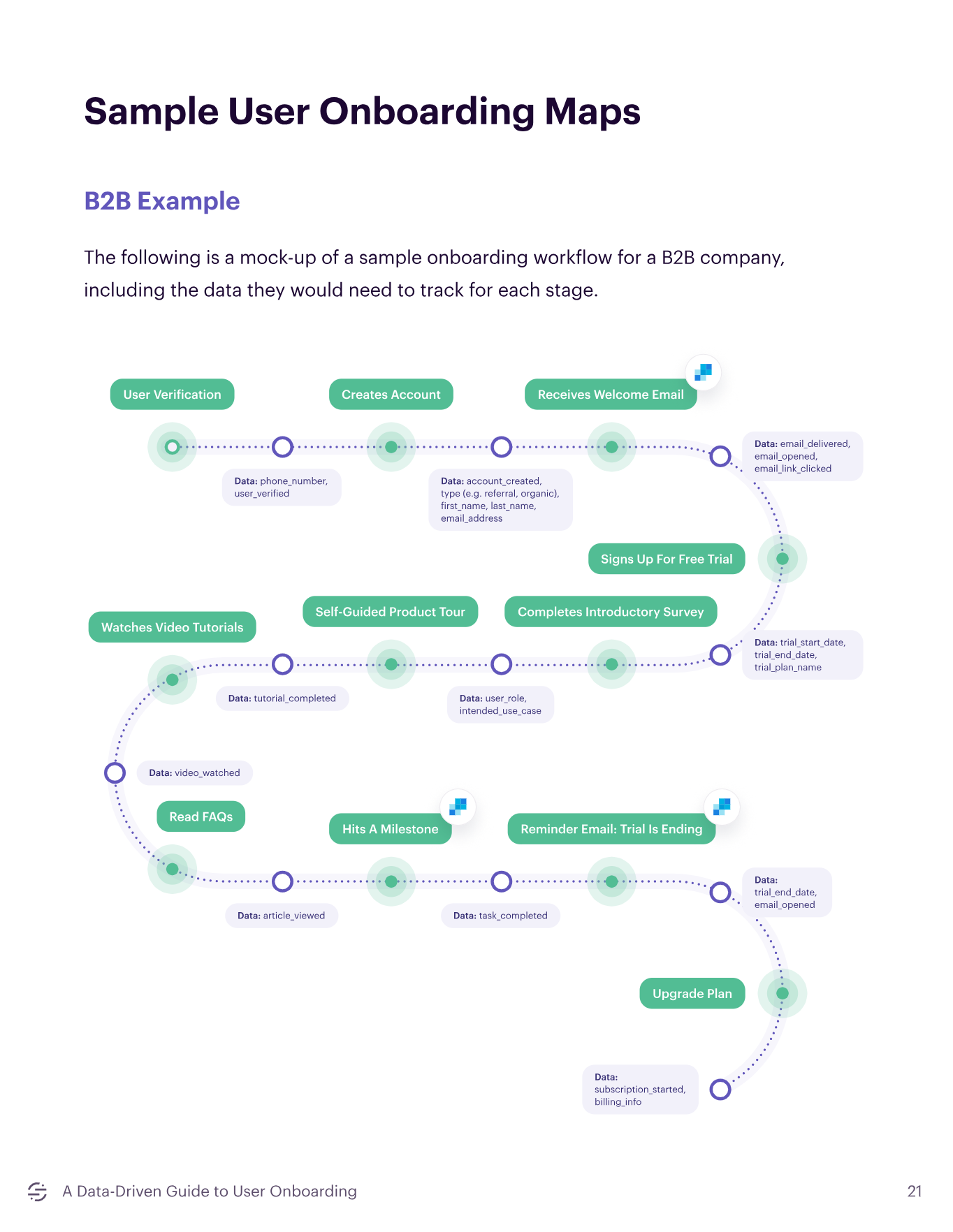
An overarching goal is to have your customers become staunch supporters of your product – not only so they remain customers, but so that they also become brand advocates.
Referrals are an incredibly powerful and cost-effective way to acquire new customers. And with the right data, you can pinpoint the most strategic time to ask customers to give a referral and even automate your referral program.
Customer journey maps are “documents that visually illustrate customers’ processes, needs, and perceptions throughout their relationships with a company,” according to Forrester Research. They identify interactions and touchpoints at every stage of the customer lifecycle.
You create these maps to understand how customers view the experience of doing business with your company – meaning you take their perspective. That’s why Forrester also calls these documents “moment of truth” maps.
There are some differences between B2B and B2C journey mapping, however, mainly: the number of touchpoints, and the number of decision-makers and stakeholders involved.
Customer journey touchpoints take place before, during, and after a sale. As B2B sales cycles tend to be longer than B2C ones, B2B customer journey maps have more touchpoints in the awareness and consideration stages.
Certain touchpoints are particularly important in B2B relationships – think reading case studies and customer testimonials, viewing product demos, comparing prices and product features, going through week 1 onboarding, and evaluating a plan upgrade.
With B2B marketing, you have to convince multiple stakeholders of your product’s value since the end-user may not be the same person with the purchasing power. You need to understand these individual personas, and engage them on the channels they prefer.
By contrast, in B2C marketing, the consumer and end-user are usually one and the same person. (Family products tend to be an exception – for example, you’d market baby products to parents, not the babies themselves.)
B2B customer journeys are becoming more complex, as more business users now expect a customer experience similar to that of B2C brands. This demand is largely driven by millennials, who are now the primary B2B decision-makers, according to research by The B2B Institute and LinkedIn.
Being digital natives, millennials are used to cloud-based software and collaboration tools, and the experience of using these services has shaped their expectations of B2B products and solutions. For instance, they demand self-service sales transactions – choose a plan, pay for it, set up an account, and go. Gartner found that 44% of millennials don’t want to interact with a sales rep when it comes to making B2B purchases.
The report notes that millennials “are being met with a wave of new digital products, brand concepts, AI-powered plug-ins and productivity tools that are more akin to the consumer user experience of Uber and Airbnb than traditional business services.” To deliver similar experiences, B2B brands like Basecamp, Stripe, and Slack have mimicked popular lifestyle apps with their high-gloss marketing campaigns, aesthetics, and emphasis on UX.
The post-sale experience is changing, too. With the rise of “everything-as-a-service” models like SaaS, businesses need to convince customers to renew their subscriptions either monthly or annually. It’s now crucial to repeatedly engage customers at the service and loyalty stages through customer retention and engagement strategies.
Plotting out the B2B customer journey is a crucial step in empathizing with your prospects (and hopefully streamlining the path to conversion). However, B2B customer journey mapping is not without its challenges. As we mentioned above, these interactions can be complex, lengthy, and span numerous touchpoints. The point being: there is rarely a linear path between awareness, conversion, and retention when it comes to B2B customer journeys.
Below, we talk about these challenges (and how to overcome them) in more detail.
For a long time, marketers have turned to third-party cookies to help them with ad attribution and retargeting prospects. But in the past few years, data privacy regulations and browser-led changes on iOS, Safari, Firefox, and Chrome have been leading to one thing: the end of third-party cookies.
However, many companies haven’t completely broken up with third-party cookies yet – meaning they may be ill-equipped to understand the customer journey in its entirety if they don’t implement a new strategy.
So, what’s the way forward? In short, a prioritization of first-party data. This type of data, which businesses gather from direct interactions with their customers, is compliant and serves as a competitive differentiator (that is, no other business has access to those insights). But for first-party data to be effective, it has to be consolidated – or in other words, there shouldn’t be any blindspots between teams when it comes to customer interactions.
One goal of customer journey mapping is to create a consistent experience across channels and touchpoints. But as the number and variety of those touchpoints grow, integrating tools can be complicated.
For instance, different tools might use different naming conventions for data collection. You’d have to standardize these names if you want to unify data from multiple sources. To create this unified view, there are a couple steps you need to take:
Create a universal tracking plan for your business that clarifies the proper naming conventions for data, what’s being tracked (and why), and where that data originates from and ends up.
Ensure this data is consolidated into a central repository and that data is democratized across teams (e.g, marketing teams don’t need to depend on analysts or engineering to pull audience lists – they can do it themselves, in real time).
The lack of integration between tools results in data silos and missed opportunities to engage customers. Let’s say sales has given a product demo to a specific prospect. If marketing doesn’t know that, they might email the prospect an invitation to try a demo. As a result, you waste the customer’s time (and your own), along with inviting their annoyance.
What are the hallmarks of an effective B2B customer journey? As we’ve explored in this article, there are a few healthy indicators: an emphasis on first-party data, a democratization of data across teams, unified, real-time customer profiles.
With consumers gravitating to multi-channel interactions, it’s become imperative for businesses to fix any blindspots that may crop up in their strategy. Effective marketing and top-tier customer experiences are now built on data, and having a scalable infrastructure in place is fundamental.
Enter, the customer data platform. CDPs have emerged as a must for businesses, helping to collect, clean and consolidate data in real time and integrate every tool and app in their tech stack. Here’s how a CDP like Segment can supercharge B2B customer journeys.
Segment’s CDP can consolidate data from every customer touchpoint, ensure it’s cleaned and validated, and then send it to any downstream destination (like email, advertising, customer service, or product development software) for activation.
A common challenge for businesses is being able to consolidate and trust the data they collect to glean insights. Too often, data silos pop up due to disconnected tech stacks, resulting in blind spots across teams. This can wreak havoc on the customer experience and business operations.
Say a customer has an issue and tries to resolve it via live chat – providing details about their account, the problem at hand, and so forth. They end up being transferred to a phone call with a representative…and have to repeat everything they just went over. Not ideal.
With consolidated, trustworthy, and accurate data, businesses can have more precision in their customer interactions, creating a better overall experience that pays dividends when it comes to greater customer satisfaction and retention rates.
Identity resolution is the process of stitching together a customer’s behavior, from across channels, into a single, unified profile. This single view of the customer is essential for effectively engaging them – giving every team a 360-degree view of how they’ve been interacting with your business. It’s a crucial component of creating a cohesive customer journey, especially when these profiles are updated in real time.
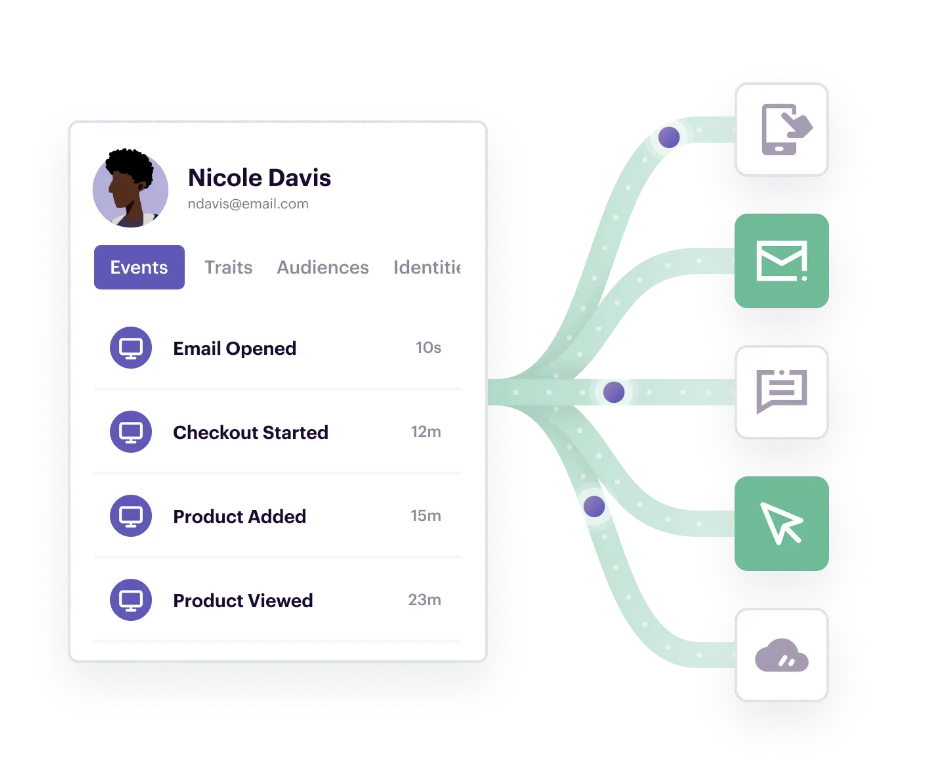
With this complete, overarching view of customer behavior, businesses can then leverage real-time data to personalize experiences at scale. For instance, with Segment Journeys, teams are able to orchestrate multi-step, and multi-channel campaigns based on a person’s actions in the moment.
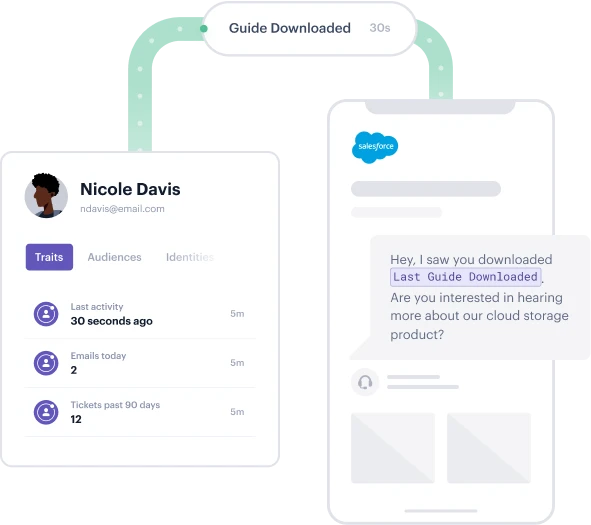
Connect with a Segment expert who can share more about what Segment can do for you.
We'll get back to you shortly. For now, you can create your workspace by clicking below.
B2B customers go through the Awareness, Consideration, Conversion, Service, and Advocacy stages.
A B2B customer journey map helps you visualize a customer’s interactions with your business from their point of view. It shows you the channels that customers prefer, the touchpoints that influence their conversion, and the experiences that tend to lead them to churn.
Seeing a social media ad, reading customer testimonials, conversing with a chatbot, and interacting with customer service are examples of customer touchpoints.
B2B customer journeys tend to have longer sales cycles and more touchpoints in the awareness and consideration stages. Several people influence the purchase decision, and they may enter the journey at different points.
Twilio Segment is a customer data platform (CDP) that unifies first-party data across multiple sources and creates customer profiles that are updated in real time. With visibility into omnichannel data, you can see when and how a customer interacts with your business before, during, and after a sale.